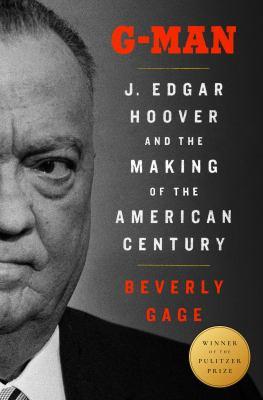
G-man : J. Edgar Hoover and the making of the American century
A major new biography of J Edgar Hoover that draws from never-before-seen sources to create a groundbreaking portrait of a colossus who dominated half a century of American history and planted the seeds for much of today's conservative political landscape. We remember him as a bulldog--squat frame, bulging wide-set eyes, fearsome jowls--but in 1924, when he became director of the FBI, he had been the trim, dazzling wunderkind of the administrative state, buzzing with energy and big ideas for reform. He transformed a failing law-enforcement backwater, riddled with scandal, into a modern machine. He believed in the power of the federal government to do great things for the nation and its citizens. He also believed that certain people--many of them communists or racial minorities or both-- did not deserve to be included in that American project. Hoover rose to power and then stayed there, decade after decade, using the tools of state to create a personal fiefdom unrivaled in U.S. history. Beverly Gage's monumental work explores the full sweep of Hoover's life and career, from his birth in 1895 to a modest Washington civil-service family through his death in 1972. In her nuanced and definitive portrait, Gage shows how Hoover was more than a one-dimensional tyrant and schemer who strong-armed the rest of the country into submission. As FBI director from 1924 through his death in 1972, he was a confidant, counselor, and adversary to eight U.S. presidents, four Republicans and four Democrats. Franklin Roosevelt and Lyndon Johnson did the most to empower him, yet his closest friend among the eight was fellow anticommunist warrior Richard Nixon. Hoover was not above blackmail and intimidation, but he also embodied conservative values ranging from anticommunism to white supremacy to a crusading and politicized interpretation of Christianity. This garnered him the admiration of millions of Americans. He stayed in office for so long because many people, from the highest reaches of government down to the grassroots, wanted him there and supported what he was doing, thus creating the template that the political right has followed to transform its party. G-Man places Hoover back where he once stood in American political history--not at the fringes, but at the center--and uses his story to explain the trajectories of governance, policing, race, ideology, political culture, and federal power as they evolved over the course of the 20th century
Available Copies by Location
| Location | |
|---|---|
| Victoria | Available |
Browse Related Items
- ISBN: 9780670025374
- ISBN: 0670025372
-
Physical Description
print
xix, 837 pages, 32 unnumbered pages of plates : illustrations ; 25 cm - Publisher [New York, New York] : Viking, an imprint of Penguin Random House LLC, [2022]
- Copyright ʻ́ø2.
Content descriptions
| General Note: | Place of publication from publisher's website. |
| Bibliography, etc. Note: | Includes bibliographical references (pages 795-815) and index. |
| Formatted Contents Note: | Introduction -- part 1. The Federal city (1895-1924). The oldest inhabitants (1800-1895) ; Little Edgar (1895-1905) ; The boy problem (1905-1909) ; Jump high and leap quick (1909-1913) ; Dieu et les dames (1913-1917) ; The great adventure (1917-1918) ; The radical division (1919) ; New elements (1920) ; No. 2 (1924-1924) -- part 2. Building the Bureau (1924-1945). Preface ; The new sleuth (1924-1925) ; Kappa Alpha Bureau (1925-1928) ; Depression days (1929-1932) ; Chairman of the Moral Uplift Squad (1927-1932) ; Government men (1933) ; The black chamber (1934) ; It's FBI now (1934-1935) ; Right-hand man (1935-1936) ; Sob sisters and convict lovers (1935-1938) ; The gathering storm (1936-1938) ; Mothers and sons (1938-1939) ; Terror by index card (1939-1940) ; Henry E. Jones (1940-1941) ; Enemy aliens (1941-1942) ; The most exciting achievement yet (1942) ; American dilemmas (1942-1945) -- part 3. Power and politics (1945-1959). Preface -- Central intelligence (1945-1946) ; Under color of law (1941-1948) ; The one bulwark (1941-1946) ; Un-American activities (1946-1947) ; Three-ring circus (1948-1950) ; J. Edgar Hoover, churchman (1948-1950) ; Atomic drama (1949-1951) ; Hooverism (1950-1952) ; Inner conflicts (1947-1952) ; A glorious year (1953) ; No sense of decency (1953-1954) ; Massive resistance (1954-1957) ; Master of deceit (1956-1959) -- part 4. The war at home (1960-1972). Preface -- New frontiers (1960-1961) ; Top hoodlums (1957-1961) ; The Federal Bureau of Integration (1957-1961) ; Patron saint of the far right (1961-1962) ; In friendship (1961-1962) ; Decadent thinking (1957-1962) ; The most dangerous negro (1963) ; The President is dead (1963) ; The commission (1963-196464) ; Freedom summer (19) ; All the way with LBJ (1964) ; The most notorious liar (1964-1965) ; White hate (1964-1965) ; Hoover knows best (1965-1966) ; Commies in colleges (1965-1967) ; Messiah (1968) ; Nixon's the one (1968-1969) ; The gospel of nihilism (1969-1970) ; The man who stayed too long (1970-1971) ; One of the giants (1972) -- Epilogue. |

